Why Every Boat Should Have a Battery Monitor ⚡️
Your boat’s DC electrical system powers everything from navigation gear to refrigeration. Yet many skippers still rely on guesswork or a simple voltmeter to judge battery health. That’s like running a diesel without a fuel gauge. Batteries can be a huge investment a battery monitor helps you to look after them and ensure that you get a good service life from them.
A battery monitor is your electrical fuel gauge. It tracks not just voltage, but also state of charge (SoC), current draw, time remaining, charging history, and the more sophisticated units will give you a reasonable estimate of battery health. With this information, you can avoid flat batteries, extend battery life, and sail with confidence in the state of health of your battery system.
Typically, battery monitors allow you to fully monitor one battery bank, the house battery bank, and monitor the voltage of an auxiliary battery (often the engine’s start battery).
This article assumes that we are using some form of lead-acid battery bank, but most of the discussion applies to Lithium-based chemistries as well. If you are planning a lithium chemistry battery, simply ensure that the monitor you choose is lithium compatible.
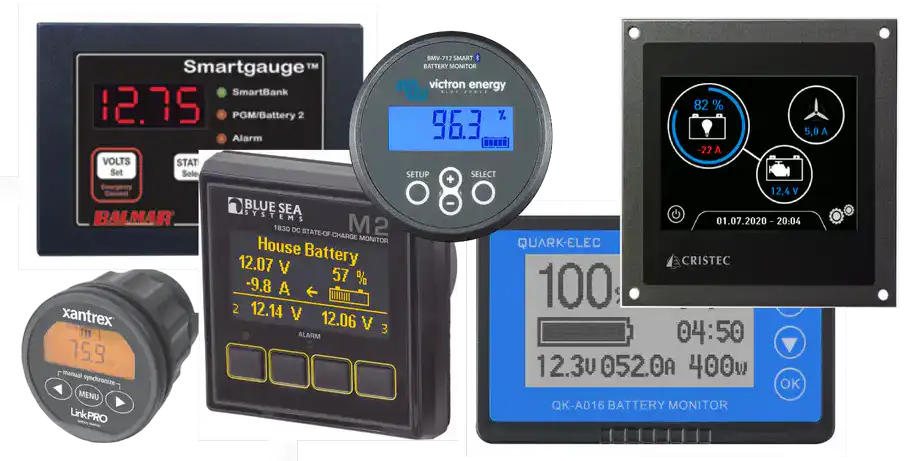
Benefits of Installing a Battery Monitor
- Reliability: Know exactly how much usable energy remains.
- Battery Health: Prevent over‑discharge and over‑charging.
- Efficiency: Track charging sources (alternator, solar, shore power).
- Integration: Many models connect to apps, NMEA2000, or helm displays.
- Peace of Mind: No more surprises when you need power most.
Battery Monitor System Components

There are just two base parts to most battery monitor systems: the shunt (the sensor) and a display unit. The brains (microprocessor) of the system can be located either in the shunt or the display unit.
Historically, the shunt was a simple passive device (a resistor) and the brains were in the display, but increasingly, so-called, smart shunts are doing the heavy lifting and sending the measured and calculated values to the display unit. This has the advantage that a dedicated display unit becomes optional as the shunt can be connected to the boat’s NMEA0183 or NMEA2000 network and the information displayed as required on any MFD.
Shunt
The shunt is a very precise low-value resistor. Using Ohm’s Law, it is a simple matter to calculate current flow by measuring the voltage difference across the resistor using the formula V/R=I, where:
- V – Voltage (volts)
- I = Current (Amps)
- R = Resistance (Ohms)
Let’s say that the resistance is 1 Ohm; in reality is much smaller, but stick with me for a moment. If you measure 1 Volt across 1 Ohm, you have 1 Amp of current flowing. But that amount of voltage drop across the shunt would be unacceptable and as the current increased, the power dissipated in the shunt would soon cook it.
Many battery monitors require about 50mV (50 milliVolts, or 0.05V) for full scale at their designed range, and the shunt’s resistance value is sized appropriately to the range of current required, eg:
- 100 A / 50 mV → R = 0.05 V / 100 A = 0.0005 Ω (0.5 mΩ)
- 200 A / 50 mV → R = 0.00025 Ω (0.25 mΩ)
- 500 A / 50 mV → R = 0.0001 Ω (0.1 mΩ)
- 1000 A / 50 mV → R = 0.00005 Ω (50 μΩ)
Display Unit
The display units show various items of information such as: voltage, current (in and out), state-of-charge (SoC) and state-of-health (SoH). The display unit is often also the interface for changing the configuration and adjusting parameters to set up and calibrate the system, although this is increasingly done via an app over Bluetooth.
Basic Principle of Operation
Very simply, a battery monitor uses the shunt to measure current flow into and out of the battery. The running total of these values gives us the capacity remaining in the battery, in principle, but not in real life.
Batteries are not 100% efficient, which means that you have to put in more power than you can take out. To make matters worse, the efficiency changes with the rate of charge or discharge and other factors such as battery age, its state of health and even the temperature.
Peukert’s Law (dating from 1897) is an attempt to explain these inefficiencies. A good explanation can be found in this article on Battle Born’s website What Is Peukert’s Law and What Is Its Effect on Batteries? | Battle Born Batteries and this Wikipedia article, Peukert’s law – Wikipedia.
Lithium chemistry-based batteries are almost unaffected by Peukert’s Law, but there is some effect, and it should not be discounted.
Calibration drift
Despite taking every care possible to carefully calibrate a battery monitor you can’t just do it once and leave it. Nearly all battery monitors suffer from calibration drift on cruising boats or in any situation where batteries are not charged to 100% every charge.
Typically, cruising boats operate their batteries in a partial state of charge (PoC) from 50 to around 85% – the reasons for this are complex, but basically, the acceptance rate (the rate at which a battery can accept charge) of a traditional lead-acid battery decreases inversely proportional to its SoC. This means that to always achieve a 100% charge, you would have to run your engine for over 7 hours. That obviously isn’t desirable or practical for yachties.
These partial charges play havoc with the calibration of most battery monitors. No amount of fiddling with Peukert’s factors and battery efficiency tables will fix this.
Installation Notes
- Shunt placement: Install the shunt in the negative battery cable, as close to the battery as possible, so all loads and chargers pass through it.
- Wiring: Use appropriately sized cables and fuses. Keep signal wiring separate from high‑current cabling to reduce interference.
- NMEA integration: Some monitors output to NMEA2000 or NMEA0183, allowing battery data to appear on your chartplotter or MFD. Learn more in our series on marine electronics networking.
Product Overviews
Victron Energy Range (SmartShunt, BMV, Lynx)
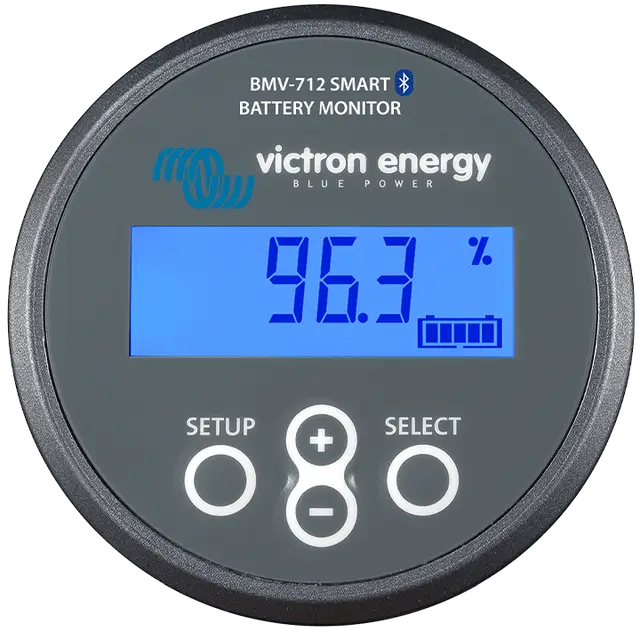
The Victron BMV-7xx series of battery monitors has been a staple of the industry for some time now. I installed a BMV-712 SMART in my own boat several years ago after installing lots of them for clients. I really wanted it as a check/compare unit to use alongside my SMARTGAUGE (see below).
Other models from Victron
BMV‑700H/710H Smart: High‑voltage versions for hybrid/electric systems.
SmartShunt: Compact, Bluetooth‑only, app‑based. Amazon
BMV‑700/702/712: Panel‑mount with LCD, 712 adds Bluetooth. Amazon
Lynx Shunt VE.Can: Heavy‑duty, integrates with Victron GX systems.
Digital Yacht BM100 (NMEA2000 Interface)
BM100 – Boat Battery Monitoring System – Digital Yacht
This is not strictly a battery monitor but a device that allows the data from a Victron SmartShunt to be distributed over the boat’s NMEA2000 network. Useful if you don’t require a stand alone battery monitor instrument or want to also share the data from a victron system to your MFD (your helm mounted plotter for example).
- Essentially a Victron SmartShunt with a Digital Yacht interface.
- Outputs to NMEA2000 for MFD display (Garmin, Raymarine, Furuno, etc.).
- Integrates battery data in Victron data format into your wider onboard network.
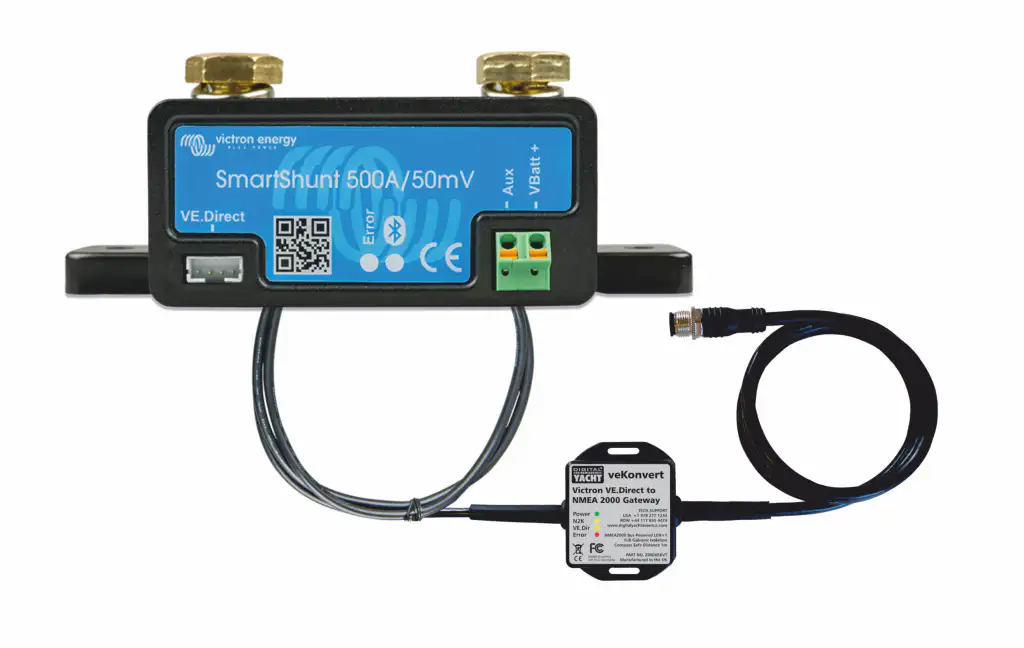
Balmar SmartGauge

This is not your traditional battery monitor, as it does not use a shunt or display current into or out of the battery. What it does do is give you a surprisingly accurate estimate of the SoC of the battery. How it does this is something of an industrial secret but I understand that it uses high-frequency pulses to measure the internal resistance of the battery.
I installed one of these on my own boat well over 10 years ago and have found it to be very accurate. Initially, I monitored it closely using traditional voltage and current meters and my own calculations, but came to trust it so much that I never doubted its readings.
Several years ago, I installed a Victron BMV-712 to compare it with and found that it was always within a couple of percent of the more complex Victron unit.
I do not doubt that, provided that you put in the effort of calibrating and periodically recalibrating the Victron and other similar units that they can give more accurate results, but most of us don’t need a scientifically accurate reading of the battery SoC, and a reliable readout that is within a couple of percent is better than a reading you can’t trust.
- No shunt required, simple 3‑wire install.
- Very intuitive SoC display.
- Lead‑acid only, no lithium support.
I suspect that these are now end of line and will be entirely replaced by the SG200 (see below), but WestMarine still have stock discounted to $153 USD.
Balmar SG200 Battery Monitor (Top Choice)
Full Kit – Amazon link
Shunt only (connect via app and Bluetooth) – Amazon link
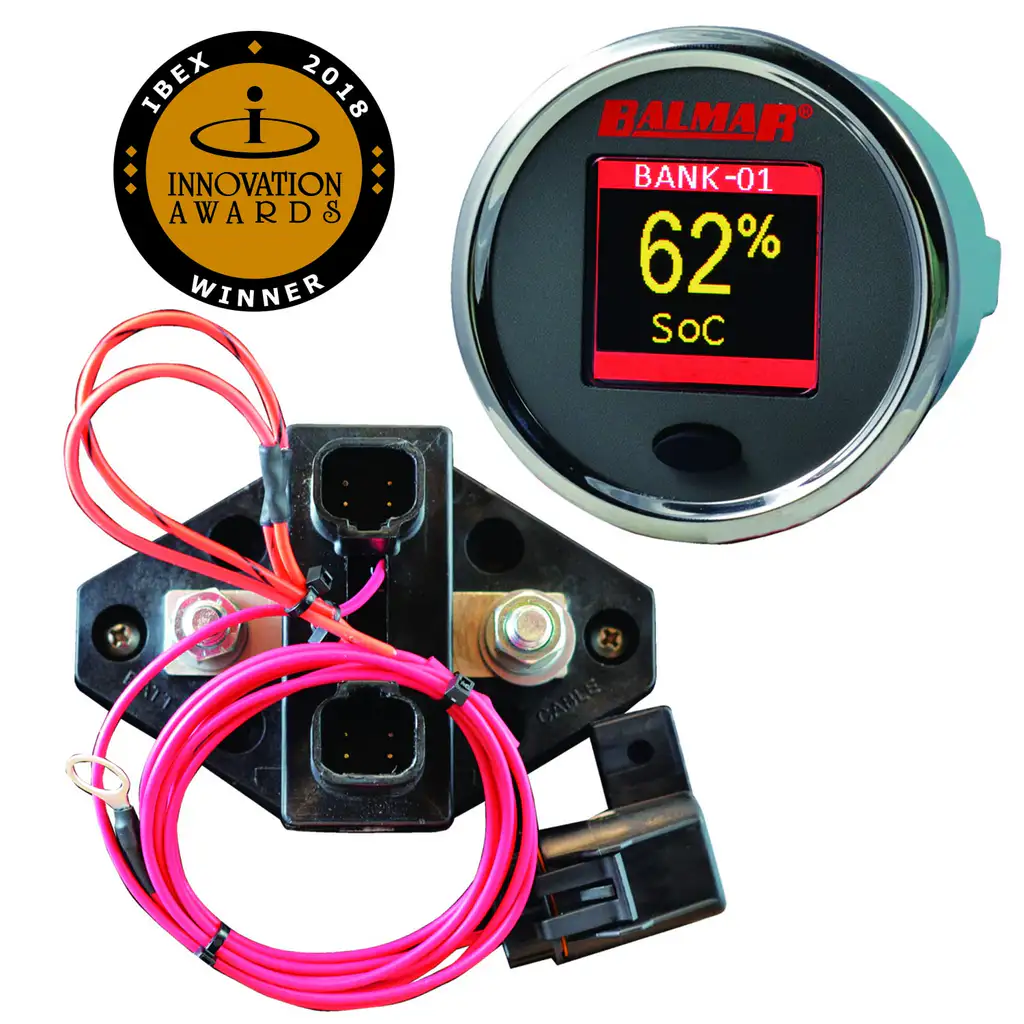
The Balmar SG200 is the generational evolution of the SmartGauge. It combines the SmartGauge’s intuitive SoC algorithm with the precision and extra information (current flow) of a shunt‑based system.
Why it’s my top choice: For most boaters, the SG200 strikes the perfect balance between simplicity, accuracy, and expandability. It’s easy to read, future‑proof, and reliable — making it the best all‑rounder.
Pros:
- Colour display with clear, real‑time data.
- SmartShunt is included for accurate amp‑hour counting.
- Expandable with multiple displays or SmartShunts.
- Optional Bluetooth app for mobile monitoring.
- Works with both lead‑acid and lithium chemistries.
Cons
- More expensive than entry‑level monitors.
- Slightly more complex installation than SmartGauge.
Xantrex LinkPRO
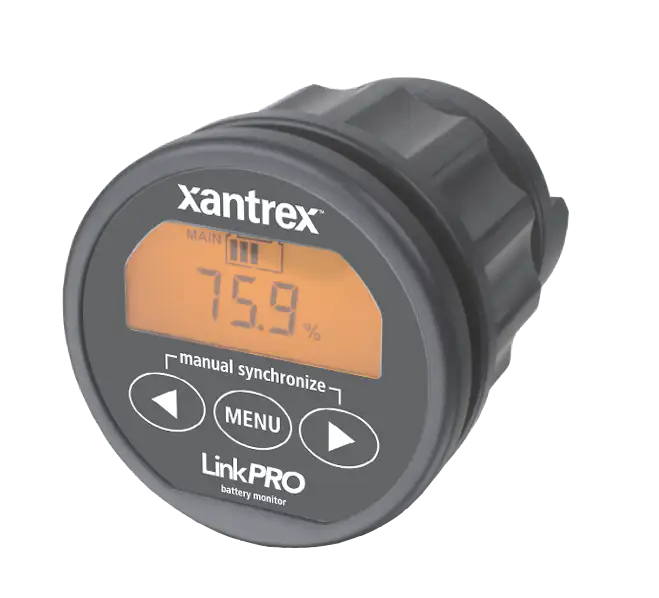
Xantrex have been in the battery monitor market for longer than anybody else, to my knowledge, and their products are very well designed and reliable.
- Full‑featured with shunt, LCD, alarms, and a generator auto‑start relay.
- More complex install, interface feels dated compared to app‑based systems.
Xantrex store on Amazon
Sterling Power BM2
Stirling Power website and store: Battery Monitor – BM2 – Sterling Power Products
There is also a simpler BM1 Model: Battery Monitor – BM1 – Sterling Power Products

Sterling Power produce a range of innovative, but sometimes quirky, power solutions. However, they all work and do what it says on the tin. Well built and dependable, but with limited worldwide support. Good gear; if you understand what you are doing and will do the installation yourself. Email support is good, but depending on where you are in the world, don’t expect your local technician to be familiar with the brand.
- Affordable, straightforward entry‑level monitor.
- Limited features and integration. Very simple battery characteristics input, so it will probably require recalibration of battery capacity regularly.
Cristec BAT‑MON
Cristec Advanced Battery Monitor for Boats Amp-Hours

This is a higher-end battery monitor that can handle multiple charging sources and battery banks. I have no experience with this particular model, but other Cristec products are excellent if somewhat pricey. This, however, seems to be reasonably value for money if you need to monitor the SoC of more than one bank.
- Monitors up to 3 banks, records history, CAN‑Bus option.
- Larger panel footprint.
Quark-Elec A016
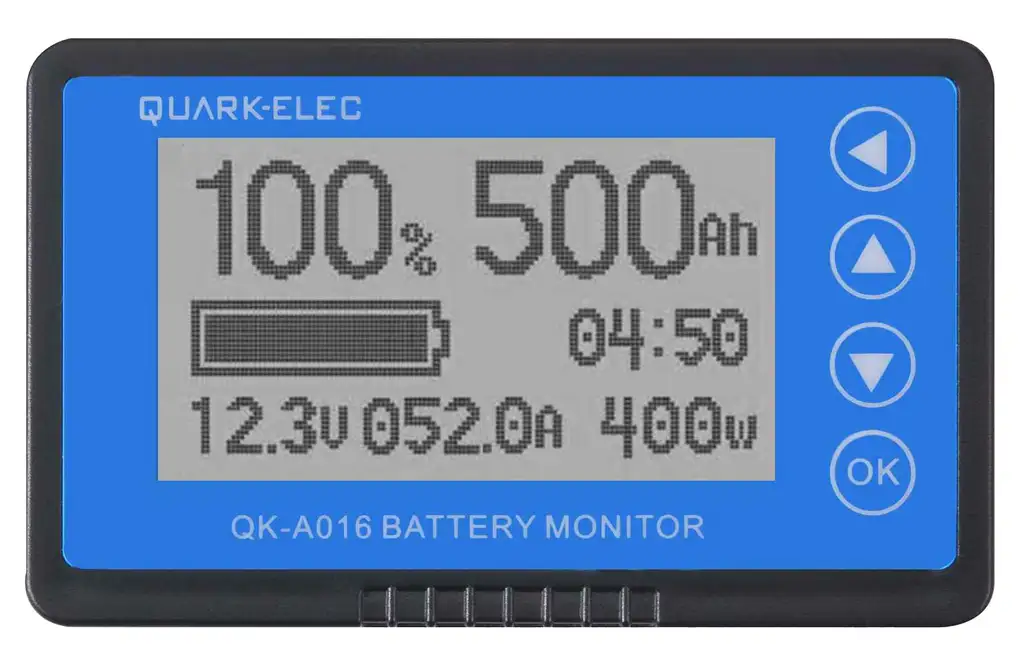
Quark-Elec are producing some nice equipment in the marine instrumentation. I have no personal experience with this unit, but based on their other products, I expect that it will do the job and do it well. It provides NMEA0183 integration as standard, allowing you to present the data on your chartplotter/MFD, which is something that only a couple of other, more expensive, units can do.
- Outputs battery data via NMEA0183.
- Works with lithium and lead‑acid.
- NMEA0183 is less user‑friendly than NMEA2000-compatible systems.
Mastervolt BattMan Pro

I suspect this is a rebranded Xantrex LinkPro, but I have included it here for completeness.
- Not MasterBus compatible, but simple and reliable.
- Affordable, splash‑proof (IP65) panel monitor.
- Displays voltage, current, amp‑hours, SoC, and time remaining.
- Stores historical events and alarms.
- Supports 12/24V systems, up to 500A shunt.
Blue Sea Systems M2 DC Multimeter with SoC

This is a pretty simple unit. Calibration inputs are limited to battery voltages, capacity and an estimated efficiency. (similar in specification to the Stirling BM1 and BM2)
- OLED display, measures SoC, current, and up to 3 voltages.
- Programmable shunt ratios support up to 500A.
- External relay activation for alarms or load shedding.
Product Comparison Table
| Brand / Model | Display | Connectivity | Battery Types | Pros | Cons |
|---|---|---|---|---|---|
| Victron SmartShunt | None (App) | Bluetooth | All incl. Lithium | Compact, easy retrofit | No dedicated display |
| Victron BMV‑712 | LCD + App | Bluetooth | All incl. Lithium | Full‑featured | |
| Victron Lynx Shunt | GX Device | VE.Can | All incl. Lithium | Heavy‑duty, modular | Needs GX device |
| Digital Yacht BM100 | MFD + App | NMEA2000 + BT | All incl. Lithium | Network integration | Requires Victron shunt, no dedicated display |
| Balmar SmartGauge | LED | None | Lead‑acid only | Simple, no shunt | No lithium support |
| Balmar SG200 | Color LCD + App | SmartLink, Bluetooth option | All incl. Lithium | Accurate, expandable, intuitive | |
| Xantrex LinkPRO | LCD | None | All incl. Lithium | Full‑featured, alarms | |
| Sterling BM2 | LCD | None | Lead‑acid, AGM | Limited features | |
| Cristec BAT‑MON | LCD | CAN‑Bus | All incl. Lithium | Multi‑bank, history | Larger panel |
| Quark A016 | LCD | NMEA0183 | All incl. Lithium | NMEA0183 integration | Legacy protocol |
| Mastervolt BattMan Pro | LCD | None | All incl. Lithium | Full‑featured, Alarms | No MasterBus |
| Blue Sea M2 | OLED | Relay output | All incl. Lithium | Alarms |
Which Monitor Suits Which Skipper?
| Skipper / Boat Type | Best Fit Monitors | Why |
|---|---|---|
| Weekend Sailor | Sterling BM2, Balmar SmartGauge | Simple, affordable, easy install. |
| Coastal Cruiser | Victron SmartShunt, BMV‑712 | Reliable, app integration, lithium support. |
| Offshore Cruiser (dedicated display) | Balmar SG200, Victron BMV‑712, Blue Sea M2 | SG200 is the best all‑rounder; detailed data and expandability. |
| Offshore Cruiser (instrument integration) | Victron SmartShunt / Digital Yacht BM100 for NMEA2000 or Quark-Elec A016 with NMEA0183 output | Full integration with MFDs, redundancy. See battery monitoring for offshore cruisers. |
| Charter / Commercial | Mastervolt BattMan Pro, Blue Sea M2, Xantrex LinkPro | Rugged, splash‑proof, intuitive displays. Regular charging to 100% will keep these accurate. |
| Tech‑savvy Owner | Quark A016, Digital Yacht BM100 | NMEA integration, networked data. |
Price Comparison
| Battery Monitor | Approximate Retail Price (USD) October 2025 |
|---|---|
| Balmar Smartgauge | $320 (discounted to $150) |
| BMV-712 SMART | $150 |
| BM100 – Boat Battery Monitoring System – Digital Yacht | $440 |
| Balmar SG200 (smart shunt and display) | $386 |
| Xantrex LinkPro | $522 |
| Sterling Power Products BM2 | $280 |
| Cristec Advanced Battery Monitor | $335 |
| Quark-Elec A016 | $150 |
| Mastervolt BattMan Pro | $350 |
| Blue Sea Systems M2 multimeter with SoC | $360 |
Conclusion
A battery monitor is one of the smartest upgrades you can make to your boat. Whether you want a simple gauge, a rugged panel, or a fully integrated NMEA2000 solution, there’s a monitor to suit every skipper and vessel. For most boaters, the Balmar SG200 stands …out as the best all‑round choice. It combines the simplicity and intuitive “fuel‑gauge” feel of the original SmartGauge with the precision of a shunt‑based system. That means you get both ease of use and hard data accuracy — a rare combination.
FAQ
Frequently Asked Questions
What is a battery monitor, and how does it benefit boaters?
A battery monitor provides real-time information about the health and state of your boat’s batteries, including voltage, current, and charge levels. This allows skippers to manage power consumption effectively, ensuring that electrical systems remain operational during voyages.
Can a battery monitor help prevent battery failure?
Yes, by continuously monitoring battery performance, a battery monitor alerts users to potential issues before they escalate. This proactive approach can prevent unexpected battery failure, ensuring a reliable power source during critical moments.
Are battery monitors easy to install on a boat?
Most battery monitors are designed for straightforward installation, requiring minimal tools and a basic understanding of electrical systems. Most come with clear instructions, making it an accessible upgrade for both novice and experienced DIY boat owners. The easiest to install, of those covered in this article, is the Balmar Smartgauge.
Do battery monitors work with both lead-acid and lithium batteries?
Yes, many battery monitors are compatible with both lead-acid and lithium battery types. This flexibility enables boaters to choose the battery technology that best suits their needs while still benefiting from accurate monitoring.
How can a battery monitor enhance energy management on a boat?
By providing insights into current battery status and usage patterns, a battery monitor enables skippers make informed decisions about energy consumption. This leads to more efficient use of resources and extended battery life, particularly during longer trips.
What features should I look for in a battery monitor?
When selecting a battery monitor, consider features such as ease of readability, compatibility with multiple battery types, and the ability to integrate with other onboard systems. Additional functionalities, such as Bluetooth connectivity, can enhance usability and data access.




